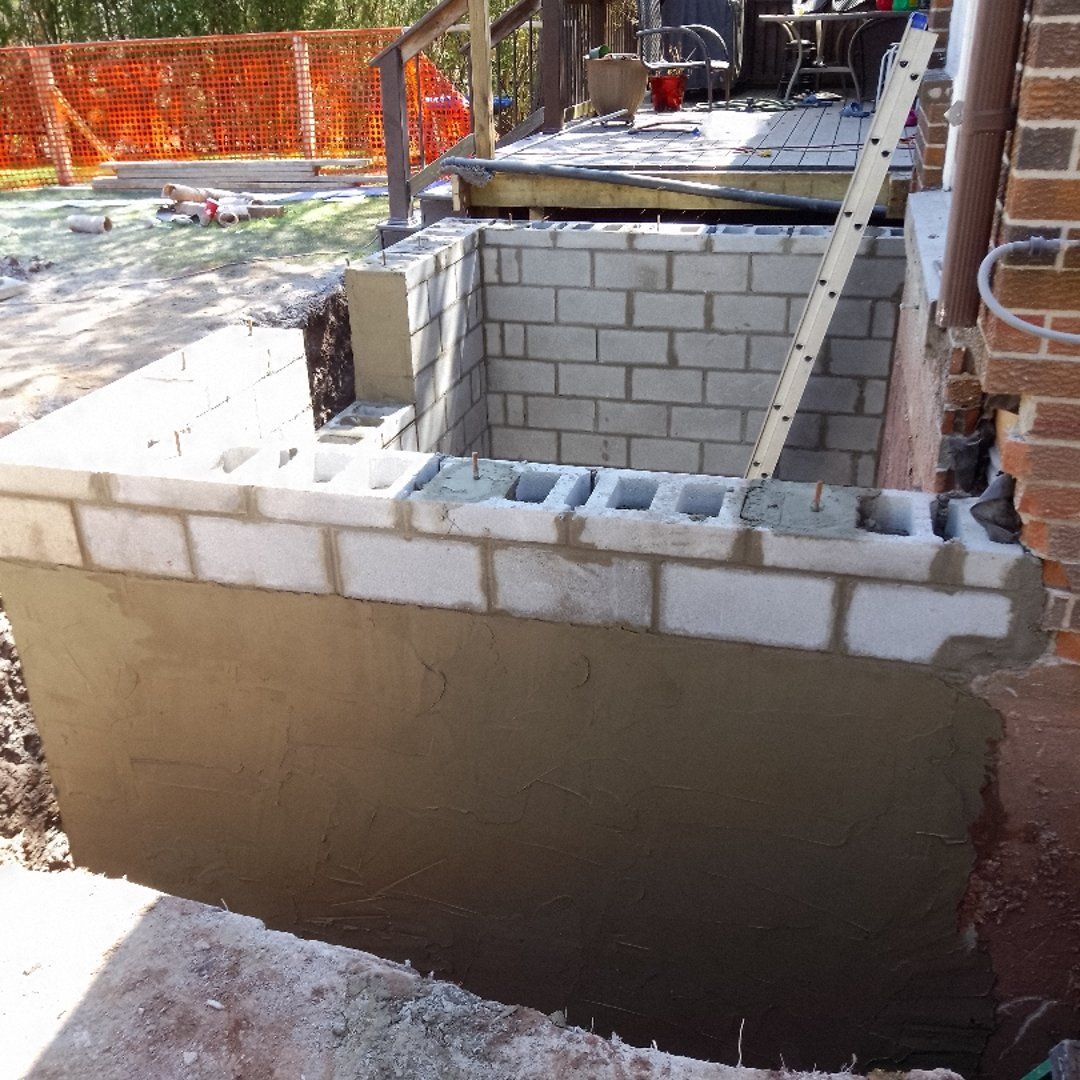Expert masonry services since 2002
Expert masonry services since 2002
Surface flaking or tired, uneven parging? We prep properly, apply a durable parge coat, and finish clean edges for a neat, consistent look across Ontario.

"Mike and Fabiano did a fantastic job on our foundation parging! They worked incredibly hard over three days and left the site in perfect condition."
- Sydney D.
Masons used lime-based mortars to cover rough stone foundations, creating smoother surfaces and better weather protection.
In harsh climates, parging became essential for protecting concrete foundations from freeze-thaw damage.
Today's techniques combine traditional methods with Portland cement and polymer additives for superior durability.
Parging is a thin coat of mortar applied to foundation walls and concrete blocks. It protects against moisture and improves appearance—turning rough concrete into a smooth, finished surface.
Traditional parging consists of carefully balanced materials that work together to create a durable, protective coating:
Parging provides thermal insulation properties that help reduce heat loss through foundation walls. While not a primary insulation method, it creates an additional barrier that can:
Choose parging for foundation walls, basement exteriors, and concrete block protection.Choose stucco for above-grade exterior walls where you want a decorative finish system.
Applied to foundation walls to create a moisture barrier and protect against weather damage
Textured finishes that enhance appearance while providing protection
Restoration of existing parging to address cracks, chips, or deterioration
Ontario's variable climate creates unique challenges for parging:
Foundation protection from moisture
Improved curb appeal and appearance
Weather and freeze-thaw resistance
Crack prevention and structural support
Enhanced moisture barrier
Cost-effective foundation enhancement
Thermal insulation properties
Extended foundation lifespan
Get a clear scope, real numbers, and no surprise add-ons for your parging project.
Answer a couple of quick questions to get a personalized estimate
Precise address helps with accurate estimates
🏠 For accurate service estimates and scheduling
Licensed • Insured • WSIB
4.9/5 from 1,200+ homeowners
Quick response
We protect landscaping and surfaces, then clean daily. No mess left behind.
A clear schedule and a finish date you can plan around.
On-site assessments, real numbers, and no surprise add-ons.
Clean surface, fix cracks, ensure good bonding
Right thickness, smooth application, consistent texture
Protect while curing, clean up completely
"The crew was fast and efficient and repaired the parging around my house in 2 days. Very happy with the quality and look of the work." - Gerald S.
Proper surface prep, quality materials, and appropriate application timing
Clean, dry surfaces and optimal weather conditions for application
Regular inspection, proper drainage, and timely crack repair
Consistent mixing procedures and uniform application conditions
15-25 years with proper maintenance
Annual visual inspection, detailed check every 3-5 years
Note: Early detection and repair can prevent larger, more expensive problems. Contact professionals when you notice any of these warning signs.
Early repairs cost less and protect your foundation better. We'll assess your parging and give you a clear plan.
Localized repairs, edge feathering, and texture blend.
Multiple areas with prep, crack treatment, and uniform finish.
Comprehensive re‑parging with moisture management and protection.
We’ll inspect your foundation surfaces, confirm the right prep and finish, and provide a fixed written plan for your home.
Enable location to see offices near you, or use featured offices below.
Parging consists of Portland cement, hydrated lime, fine sand, and water. Modern applications often include polymer additives to improve adhesion and flexibility. The typical ratio is approximately 1 part cement, 2-3 parts sand, with lime added for workability.
Quality parging typically lasts 15-25 years with proper application and maintenance. Lifespan depends on climate conditions, foundation movement, drainage, and the quality of initial installation.
While possible, parging requires specific skills for surface preparation, proper mixing, and application technique. Poor DIY application often leads to adhesion problems, cracking, and moisture issues. Professional application ensures proper materials, technique, and longevity.
Common causes include freeze-thaw cycles, foundation settlement, poor surface preparation, incorrect mix ratios, and rapid drying. Ontario's climate makes proper application timing and quality materials essential for crack prevention.
Replace parging when you notice widespread cracking, large areas flaking off, hollow sounds when tapped, or visible moisture penetration. Small cracks can often be repaired, but extensive damage requires complete renewal.
Parging provides moisture resistance but is not a complete waterproofing solution. It helps shed water and reduces moisture penetration, but foundations with significant water issues may require additional waterproofing measures.
Yes, parging can include various textures and finishes for decorative appeal. Options include smooth, textured, stamped patterns, or colored additives. Decorative parging combines protection with enhanced curb appeal.
Parging is typically applied to foundation walls and concrete blocks in thin coats (3-6mm), while stucco is a thicker coating system (15-25mm) used on above-grade walls. Stucco often includes multiple layers and mesh reinforcement.
Annual visual inspections, prompt crack repair, maintaining proper drainage around foundations, and avoiding impact damage. Clean gutters and ensure water flows away from the foundation to prevent moisture-related deterioration.
Parging should not be applied when temperatures are below 5°C or when freezing is expected within 24 hours. Cold weather can prevent proper curing and cause frost damage. Spring and fall are optimal application seasons in Ontario.
Typical parging thickness ranges from 3-6mm (1/8 to 1/4 inch). Thicker applications may crack due to shrinkage, while thinner coats may not provide adequate protection. Professional assessment determines optimal thickness for each situation.
Surface must be clean, sound, and slightly damp. Remove loose material, repair cracks, clean with wire brush or pressure wash, and apply bonding agent if needed. Proper preparation is crucial for long-lasting adhesion.
We'll inspect your foundation surfaces, confirm the right prep and finish, and provide a clear scope with real numbers.
info@fixmybrick.ca • Serving the GTA and surrounding areas